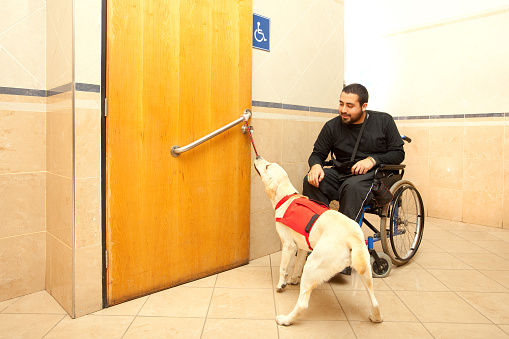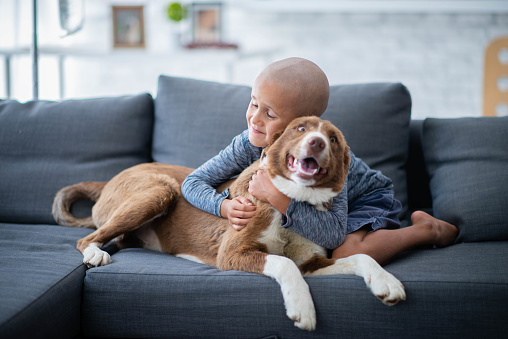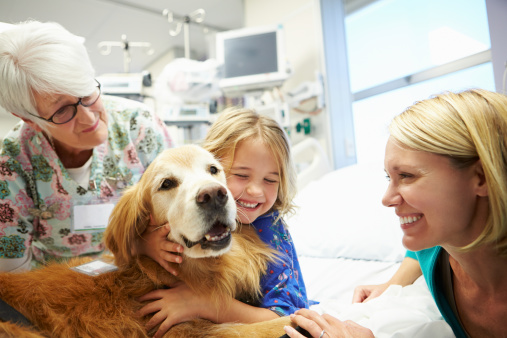In short, therapy dogs are dogs who go with their owners into volunteer settings such as hospitals and nursing homes. Therapy dogs and their owners work as an elite team to improve the lives of the people they visit. They can help people recover from emotional trauma, physical injury, or sickness. Keep reading to learn more about these fantastic dogs.
Service Dogs vs. Emotional Support Animals vs. Therapy Dogs
Before we talk more about what therapy dogs are, let’s quickly discuss what therapy dogs are not. Service dogs, emotional support animals, and therapy dogs are all unique distinctions made for particular animals, but these phrases are not interchangeable.
Service Dogs
A service dog is trained to work alongside someone with a particular disability, assisting that person. These disabilities can be mental or physical, and the dog is trained to specifically assist with that specific disability and that specific person. Service dogs include dogs that see for the blind, hear for the deaf, or help someone with mobility issues accomplish tasks like opening doors or retrieving items. These dogs can let their epileptic owner know they are about to have a seizure or that their diabetic owner has dangerous blood sugar levels. Professional trainers rigorously train service dogs to take on their specific tasks. Service dogs are allowed almost anywhere their owner is permitted.

Emotional Support Animals
As the name implies, an emotional support animal, or ESA, doesn’t have to be a dog, it can be a variety of animals. These animals are companions to their humans that provide emotional support. They are often involved in psychological therapy to treat emotional disorders as ordered by a psychiatrist. These disorders can include but are not limited to PTSD, depression, learning disabilities, anxiety, or any range of phobias. The requirements for a dog to become an ESA are not nearly as stringent as those of a service dog, and these animals are not given nearly the level of access to public spaces.

Therapy Dogs
Therapy dogs are also sometimes called “comfort dogs.” They provide positive attention and comfort to individuals to support mental health. This person could be suffering from psychological or physical ailments, but the therapy dog’s job is to provide mental relief and comfort during their health challenges.
- Children or adults in a long-term hospital setting
- Elderly folks living in an assisted care facility
- People residing in a rehabilitation or recovery facility
- Children with learning disabilities try to focus on complex tasks such as learning to read
- Folks with confusing memory issues such as Alzheimer’s or Dementia

What Makes a Good Therapy Dog?
The most important characteristics a therapy dog must possess are the correct temperament and personality for the job. Therapy dogs must be pleasant and friendly, capable of meeting many strangers in many environments. They must be able to meet people of every size, shape, color, and stage of physical or emotional recovery.
Therapy dogs need to enjoy and be eager to be touched. These dogs need to adapt quickly to new surroundings and people and follow their handlers’ instructions. The right dog will be able to stay calm anytime, anywhere. There’s a good reason we call therapy dogs elite!

What Do Therapy Dogs Look Like?
Though any type of dog with the right temperament can be a therapy dog, some breeds often take up this monumental task.
1.Golden Retrievers
Golden retrievers are one of the most popular family dogs, and for good reason; they are gentle, eager to please, and great with children. Their award-winning smiles don’t hurt either!
2.Labrador Retrievers
Like Goldens, Labs are intelligent and sweet. Though some are pretty energetic, a calm labrador makes the perfect therapy dog.
3.Pugs
Pugs’ large eyes, wrinkly skin, and small size make them adorable therapy dogs even the smallest of children won’t find intimidating. They are naturally sociable and friendly with strangers, which is an essential personality trait for this line of work. Pugs enjoy the attention, and their playful antics make everyone around them smile.
4.Saint Bernards
Like the Bernese Mountain Dog, Saint Bernards have earned their nickname as “Gentle Giants.” This breed is calm, affectionate, and patient. They are soft and friendly, and kids love to give these mammoth dogs giant hugs.
5.Cavalier King Charles Spaniels
Cavalier King Charles Spaniels are small, friendly lap dogs. They have been bred for centuries to comfort and care for people.

Therapy Dogs To Brighten People’s Lives
No matter under what circumstances you might meet therapy dogs, they will brighten your day. These dogs have a special ability to bring smiles and comfort to everyone they meet. Though a difficult job, a dog with the right personality can change the lives of thousands of children and adults by simply being themselves. When paired with a knowledgeable and capable handler, there is no limit to what positive energy a therapy dog team can bring to the world.
